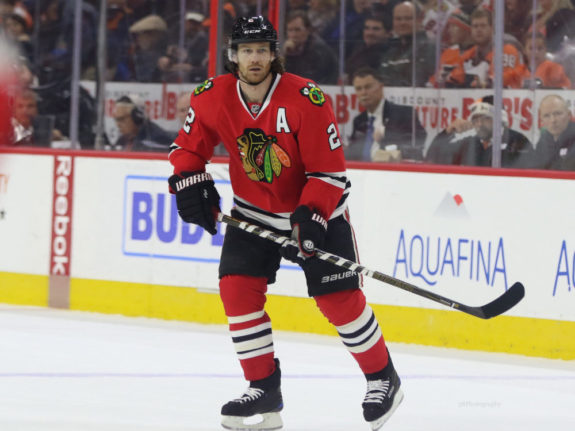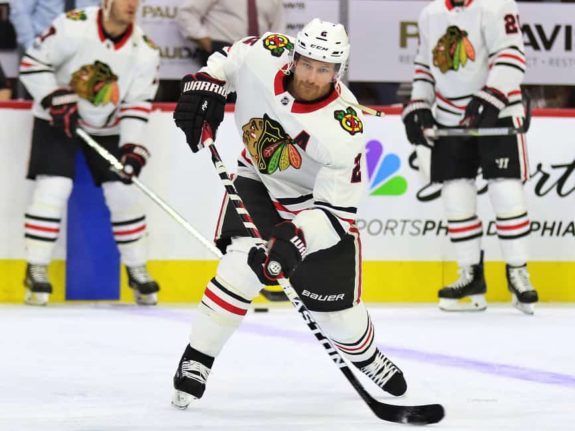The next installment of our Blackhawks 2020-21 Player Grades series will take a look at Duncan Keith’s season. The veteran defenseman’s numbers have been in a steady decline for the past few seasons and this one was no exception. However, the poor numbers, at least to his standards, may not be entirely his fault.
Related – Chicago Blackhawks 2020-21 Player Grades
Keith is a player who will get eaten alive by the analytics crowd. His metrics are not good and far from where they were when he was in his prime. However, when you take a look at the whole picture, like who he was paired with and his usage, you could argue he did the best he could with the cards he was dealt.
Overall Season Stats
Standard: 54 games played (GP), 4 goals (G), 11 assists (A), 15 points (P), minus-13, 30 penalty minutes (PIM), 110 shots on goal (S), 3.6 shooting percentage (S%), 23:25 average time on ice (ATOI), 91 blocked shots 33 hits, 28 takeaways, 63 giveaways

Advanced Metrics: 44.25 Corsi for percentage (CF%), 99.5 PDO, 43.48 goals for percentage (GF%), 42.64 expected goals for percentage (xGF%), 2.39 goals for per 60 mins (GF/60), 3.11 goals against per 60 mins (GA/60), 30.27 shots for per 60 mins (SF/60), 37.77 shots against per 60 mins (SA/60), 2.29 expected goals for 60 mins (xGF/60), 3.08 expected goals against per 60 mins (xGA/60), 2.1 goals against replacement (GAR), 0.4 wins against replacement (WAR), 0.7 standing points against replacement (SPAR)
All stats courtesy of Evolving Hockey.
It’s All About the Usage
First and foremost, one can never question Keith’s work ethic and passion for the game. He is in better shape than most players born a decade earlier. However, when it comes to how he is used within a game it comes down to the old saying “just because you can, doesn’t mean you should.” Just because Keith can lead the team in ATOI, doesn’t mean he should. Just because he can quarterback the top power-play unit, doesn’t mean he should. I think you see where I’m going here.
Keith led all players with 23:25 ATOI per game, over a full minute more than Connor Murphy. As the season went on, his ice time increased. This is not the greatest idea for a 37-year-old defenseman during a condensed season. In his final 12 full games of the season, he played over 24 minutes in eight of them. He played a season-high 29:48 against the Columbus Blue Jackets on April 12.
When you break down his possession numbers and advanced metrics, it’s not pretty. He had a career-low CF% and xGF%. Now, you can’t blame that solely on Keith, as this was an issue for the entire team. They spent entirely too much time in their own zone giving up shot and after shot and scoring chance after scoring chance.
When you throw away the numbers and just use the eye test, that didn’t fare well for him either. There were many times where he was caught chasing out of position or just standing 10 feet in front of his net wondering how the puck got in behind his goaltender. You can pin his decline in the metrics department to age, but it is no coincidence this decline was sped up when Jeremy Colliton arrived. You don’t have to be a hockey expert to see that Keith and Colliton’s defensive system just hasn’t jived together in three seasons.

The entire season wasn’t a wash for Keith. When he played within himself and took a conservative approach, he was solid. Unfortunately, inconsistency plagued his game and there were too many moments where he went rouge and got caught far out of position which often led to disaster.
For years, Keith had the stability of Brent Seabrook as his partner. With Seabrook out of the picture, Keith was paired with seven different partners during the season. Ian Mitchell, Adam Boqvist, and Murphy were the players he spent the most time with. Believe it or not, his best numbers were with Boqvist, putting up a 47.46 CF% and 47.14 xGF.
Overall Grade: C
A C grade is the perfect summation of Keith’s 2020-21 season. There were times when he played very well and showed he still has plenty to offer. Then were plenty of moments where he looked overwhelmed on the ice and frustrated on the bench. His overall performance was somewhere in the middle. Not great, but not terrible either.

Going forward, Keith will need to be managed properly and put in positions to succeed. He is no longer the workhouse, elite top defenseman, and should not be expected to maintain that role. However, it may no longer be Colliton’s decision on how to use the veteran defender.
On June 30, Elliotte Friedman of Sportsnet reported that the Blackhawks are looking to trade Keith to a team in either the Pacific Northwest or Western Canada. Shortly after that, Scott Powers had a source from within the team tell him it was Keith who got the ball rolling on the trade talks.
“We weren’t looking to move him, but it was initiated by Duncan,” a source said. “He’d like to be closer to his son. He’s getting older, and Duncan didn’t get to see him much last season. We understand that.”
From “Could Duncan Keith be traded?: What I’m hearing about the Blackhawks’ offseason” by Scott Powers – The Athletic, 7/2/21
Of course, any trade would have to be approved by Keith first due to his no-movement clause. It is sure sounding that he has played his final game with the Blackhawks. No matter what roster he is on come opening night, he is a Blackhawks legend and his No. 2 will be hanging from the United Center rafters one day.